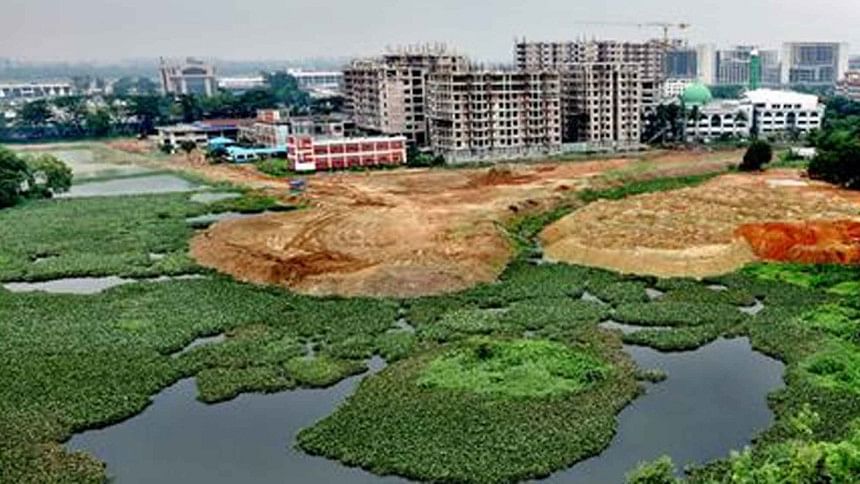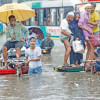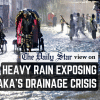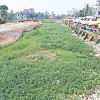When urbanisation and waterlogging go hand-in-hand

The rainy season has just set in, and we have already started to experience waterlogging in many parts of Dhaka. It is just a matter of time now till the entire city faces severe waterlogging-related problems with the persistent rains of monsoon. There is no reason for us to think anything different would happen this year – since we haven't heard of any coordinated plans being made by the authorities to rid the city of this recurring problem.
Although we see road repair work being done throughout the year for the improvement of the city's drainage system, the haphazardly done work does little to improve the situation – rather, it creates chaos and intensifies traffic jams. Meanwhile, in some parts of the city, waterlogging has now become a year-long phenomenon rather than being just a seasonal nuisance.
Dhaka is already one of the least liveable cities in the world due to its toxic air, unsafe drinking water, noise pollution, traffic congestion and high population density. And the recurring waterlogging problem during every monsoon has only added to the woes of its residents who are already overburdened by the many problems they face, day in and day out.
I wonder if there is any other city in the world where ponds, canals, rivers and other natural water bodies are filled up indiscriminately in the name of "development," creating waterlogging in the process. Or is it only Bangladeshi cities where people have to experience this unique problem – not only in Dhaka, as waterlogging has also become a reality in many parts of Chattogram and Sylhet city?
Newspapers have recently been reporting about the waterlogging problem of Ashkona, Uttar Khan, Dakkhin Khan under the Dhaka North City Corporation (DNCC) – which we fear will further worsen in the coming months. The daily Prothom Alo reported that around 52 spots of the newly added seven wards under the DNCC have been facing regular waterlogging, while in 17 spots the problem has gotten severe. A report published by The Daily Star in early May exposed the perennial waterlogging that the residents of East Jurain under DSCC have been facing – reportedly, some parts of the neighbourhood have been experiencing waterlogging for over 20 years now. The round-the-year waterlogging has forced many of its residents to leave the area for good.
Apparently, the reason for waterlogging in East Jurain is that the entire area was developed on the flood flow zones and low-lying agricultural land. The growing settlements have also blocked many of the major canals of the area such as Kutubkhali, Shabujbag, and Titas, which used to drain the excess rainwater out of the area. Besides the receding number of water retention areas, the lack of a proper drainage and waste management system has also played a big role in creating waterlogging in East Jurain.
A majority of the canals, ponds, and water retention areas in Dhaka city have faced the same fate as those in East Jurain within the past few decades. A 2019 study, done by the Bangladesh Institute of Planners (BIP), found that individuals, businesses, real-estate developers, organisations, and even government agencies have grabbed 1,072 acres (57 percent) of the 1,879 acres of flood flow zones in Dhaka metropolitan areas in the last few decades.
The Detailed Area Plan (DAP) for Dhaka has been formulated, and ample laws to preserve the water bodies in the city have been put in place, but implementing them is still a major challenge for us. This is because we have failed to create a culture where people in power – often with political backing – can be held accountable for their misdeeds. Our failure in implementing the DAP and the relevant laws thus have further emboldened grabbers.
One by one, the ponds, lakes and water bodies are vanishing from our cityscape despite desperate pleas made by city dwellers and environmentalists. The most recent incident of grabbing happened in the capital's Ashkona – by none other than a government agency. Reportedly, the Civil Aviation Authority of Bangladesh (CAAB) has started to fill up the 30-acre pond – which has been used as a water retention body in the neighbourhood for the last 50 years – for a housing project for its staff members.
CAAB has not only violated the country's existing conservation laws, such as the Playground, Open Spaces, Gardens, and Water Bodies Conservation Act 2000 – according to which, no one can fill up water bodies or stop the natural water flow – but it also hasn't bothered to seek permission from the Rajdhani Unnayan Kartripakkha (Rajuk) (which had earmarked the pond as a water body in the DAP) before starting the work. Filling up this large pond will not only aggravate waterlogging in the DNCC's Ashkona, Uttar Khan and Dakkhin Khan areas, but may also create waterlogging in the airport area, as feared by experts and locals.
When government agencies violate the laws of the land, it gives a green signal to other grabbers to continue on with their environmentally harmful activities. We cannot let that happen; we cannot let grabbers take advantage of their positions of power. We must preserve our remaining water bodies at all costs.
But that will only be possible if the concerned government agencies are sincere and politically committed to addressing the issue. Will they learn a lesson from the situation of East Jurain – the once low-lying beautiful agricultural land that has been turned into a man-made mess and, consequently, the worst place to live in Dhaka?
Naznin Tithi is a member of the editorial team at The Daily Star.

 For all latest news, follow The Daily Star's Google News channel.
For all latest news, follow The Daily Star's Google News channel. 








Comments